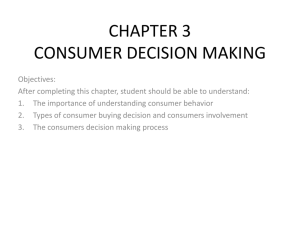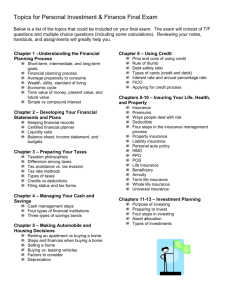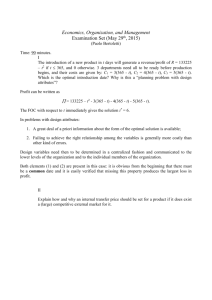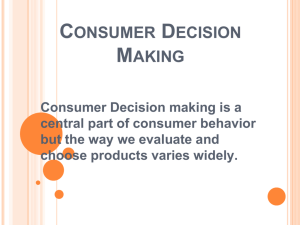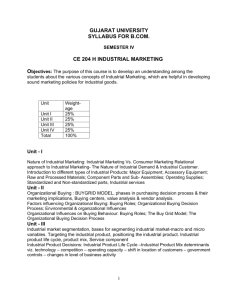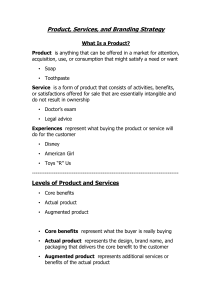File
advertisement
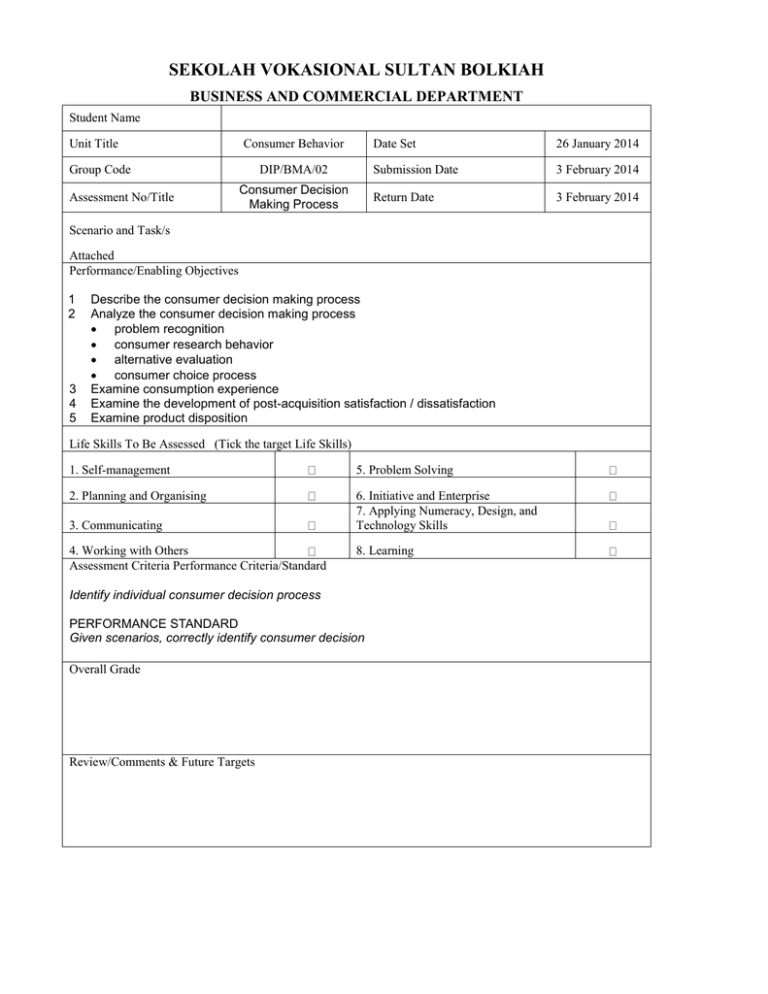
SEKOLAH VOKASIONAL SULTAN BOLKIAH BUSINESS AND COMMERCIAL DEPARTMENT Student Name Unit Title Consumer Behavior Group Code Assessment No/Title DIP/BMA/02 Consumer Decision Making Process Date Set 26 January 2014 Submission Date 3 February 2014 Return Date 3 February 2014 Scenario and Task/s Attached Performance/Enabling Objectives 1 2 3 4 5 Describe the consumer decision making process Analyze the consumer decision making process problem recognition consumer research behavior alternative evaluation consumer choice process Examine consumption experience Examine the development of post-acquisition satisfaction / dissatisfaction Examine product disposition Life Skills To Be Assessed (Tick the target Life Skills) 1. Self-management 5. Problem Solving 2. Planning and Organising 6. Initiative and Enterprise 7. Applying Numeracy, Design, and Technology Skills 3. Communicating 4. Working with Others Assessment Criteria Performance Criteria/Standard 8. Learning Identify individual consumer decision process PERFORMANCE STANDARD Given scenarios, correctly identify consumer decision Overall Grade Review/Comments & Future Targets Consumer Behavior What is Consumer Buying Behavior? Buying Behavior is the decision processes and acts of people involved in buying and using products. Marketers need to understand why consumers make the purchases that they make?, what factors influence consumer purchases? And the changing factors in our society. Consumer Buying Behavior refers to the buying behavior of the ultimate consumer. A firm needs to analyze buying behavior for: Buyers’ reactions to a firms marketing strategy has a great impact on the firms success. The marketing concept stresses that a firm should create a Marketing Mix (MM) that satisfies (gives utility to) customers, therefore need to analyze the what, where, when and how consumers buy. Marketers can better predict how consumers will respond to marketing strategies. Characteristics affecting consumer behavior 1. Initiator: the person who first suggests or thinks of the idea of buying a particular product or service. 2. Influencer: a person whose views or advice carries some weight in making the final buying decision. 3. Decider: the person who ultimately makes a buying decision or any part of it whether to buy or not, what to buy, how to buy, or where to buy. 4. Buyer: the person who makes an actual purchase. 5. User: the person who consumes or uses a product or service. Stages of the Consumer Buying Process Six Stages to the Consumer Buying Decision Process (For complex decisions). Actual purchasing is only one stage of the process. Not all decision processes lead to a purchase. All consumer decisions do not always include all 6 stages, determined by the degree of complexity. The 6 stages are: 1. Problem recognition – first the consumer must recognize a need, desire, or problem. Once you recognize the need, you are on the decision-making path to buy a product or service. Difference between the desired state and the actual condition. (a) Deficit in assortment of products. Hunger - Food. Hunger stimulates your need to eat. (b) Can be stimulated by the marketer through product information- did not know you were deficient? E.g. see a commercial for a new pair of shoes, stimulates your recognition that you need a new pair of shoes. 2. Information search – next the consumer gathers information about alternative solutions. (a) Internal search, memory. (b) External search if you need more information. Friends and relatives (word of mouth). Marketer dominated sources; comparison shopping; public sources etc. A successful information search leaves a buyer with possible alternatives, the evoked set. For example, you are hungry and want to go out and eat. Evoked set is Chinese food, Indian food, burger king, etc. 3. Evaluation of alternatives – after gather information the consumer evaluates the various alternatives to determine which is best. Sometimes this involves summarizing the information, comparing the pros and cons of each choice, making tradeoffs between price and various options, and ranking the alternatives. For example, if you are not satisfied with your choice of restaurant, then return to the search phase. Can you think of another restaurant? Look in the yellow pages etc. Information from different sources may be treated differently. Marketers try to influence by "framing" alternatives. 4. Purchase decision - choose buying alternative, includes product, package, store, method of purchase etc. 5. Purchase – if a suitable choice is available, the consumer selects the product or service from the alternatives and makes the purchase. 6. Post-purchase evaluation – at this point the consumer judges the satisfaction or dissatisfaction with the product or service purchased. Cognitive Dissonance - have you made the right decision? This can be reduced by warranties, after sales communication etc. You have gone a number of tutorials and group discussions that we can identify the key issues that we develop a good strategy for marketing a products or services. You are required to conduct a detailed survey on the following five areas. 4 Describe the consumer decision making process 5 Analyze the consumer decision making process problem recognition consumer research behavior alternative evaluation consumer choice process 6 Examine consumption experience 6 Examine the development of post-acquisition satisfaction / dissatisfaction 7 Examine product disposition Task: 1 (15 Marks) Develop a Gantt chart for the whole survey showing the comparison of plan and actual path/s. Task: 2 (15 Marks) Develop a comprehensive survey form on five issues. (Make 4 to 5 questions for each area) Task 5 (15 Marks) Develop a target group/s for respondents (Minimum 250 respondents) (E.g. SVSB students, SVSB staff, Friends and Families group) Task: 5 (35 Marks) Distribute, Collect, Processes and evaluate the data. Show the division of teams for each question (e.g. Q1 to Q5 and Q6 to Q12 etc.) Task: 6 (15 Marks) Make the presentation of the Survey. (Apply a combination of MS PowerPoint and MS Excel). Task: 7 Submit all the reference material and resources that you have applied and use. (05 Marks)
